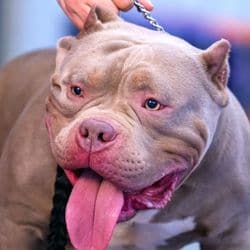American bully breeds are some of the giant dogs out there. They are loyal and protective and make great family pets. Their size is often a deterrent for people looking to adopt one of these dogs. However, with the proper care and training, an American bully can be a great addition to any home.
Do you have a big heart and want to provide a loving home for an American Bully?

American bullies are often seen as intimidating because of their large size. Their size is often misunderstood and taken as a sign that they are aggressive. However, this is not the case. American bullies are gentle giants that just happen to be significant.
We know that finding information about the size of different American bully breeds can be difficult. We’ve created this growth chart and size chart to help you better understand how big your dog could potentially get. This information is essential for anyone interested in adopting one of these dogs.
What is the American Bully Breed?
The American Bully breed is a newer breed created in the United States in the 1990s. This breed mixes several bully breeds, including the American Pit Bull Terrier, American Staffordshire Terrier, and Staffordshire Bull Terrier.
The American Bully was bred to be a companion dog and does not have the same aggressive tendencies as other bully breeds. This breed is known for being loyal, loving, and protective of its family.
While the American Bully was initially bred in the United States, this breed has gained popularity worldwide. American Bullies are now recognized by several different kennel clubs, including the International Bully Kennel Club and the American Bully Kennel Club.
Why Choose an American Bully?
There are many reasons why people choose to adopt an American Bully. Some people appreciate the breed for its loyalty and protective nature. Others find that American Bullies make great family pets because of their gentle disposition.
Regardless of the reason, it’s essential to do your research before adopting any dog. You want to be sure that you’re prepared to provide a loving home for your new pet.
How big do American Bullies get?
This is a common question that potential adopters have about the American Bully breed. The answer to this question can vary depending on the specific bloodline of the dog.
On average, an American Bully will weigh between 50 and 70 pounds. However, some dogs may be larger or smaller than this range. It’s important to remember that every dog is unique and will reach its full size at different rates.
The Height of an American Bully can also vary depending on the bloodline. However, most dogs will fall between 17 and 20 inches tall at the shoulder.

Size and Growth Chart of American Bullies
For more accurate information on the size of your American Bully, refer to the chart below. This chart includes data on weight and height based on different categories.
There are different categories of American Bullies: Pocket, Standard, Classic, and XL.
Height
Here’s a chart of how American Bully’s Height varies by category:
Pocket American Bullies are the smallest category of dog.
Male Height: 14”-17”
Female Height: 16″-19″
Standard
Standard American Bullies are the most common size dog.
Male Height: 17″-29″
Female Height- 16″-19″
Classic
Classic American Bullies are larger than Standards but smaller than XLs.
Male Height: 17″-29″
Female Height: 16″-19″
XL
Extra Large American Bullies are the largest category of dog.
Male Height: 20” to 23″
Female Height: 19” to 22″
Weight
An American bully’s weight is an essential factor when determining its size. Here’s a chart of how weight varies by category:
Male Weight: 30-50 pounds
Female Weight: 25-40 pounds
Standard
Male Weight: 50-70 pounds
Female Weight: 40-60 pounds
Classic
Male Weight 80-120 pounds
Female Weight: 60-100 pounds
XL
Male Weight: 120+ pounds
Female Weight: 100+ pounds
As you can see, there is a lot of variation in the size of American Bullies. It’s important to remember that your dog may not fall perfectly into one of these categories.
The best way to determine the size of your American Bully is to consult with your veterinarian or breeder. They will be able to give you more accurate information based on the American bully puppy weight chart and the specific bloodline of your dog.
American Bully Head Growth Chart
How to Measure Your Dog’s Height for Accurate Sizing?
Most dog owners want to get an accurate measurement of their dog, and there are a few things you’ll need.
- First, you’ll need a measuring tape. You can find a measuring tape at any hardware store.
- Second, you’ll need someone to help you hold the measuring tape while taking your dog’s measurements.
- To measure your dog, start by placing the measuring tape at the base of its neck. Then, extend the tape down their back to the bottom of their tail. Next, measure from the ground to the highest point of their shoulder. Finally, measure from one front paw to the other across the chest.
Once you have these measurements, you can consult the chart above to determine the approximate size of your American Bully. Remember, every dog is unique and will reach its full size at different rates.
How to Properly Weigh Your Dog?
It’s essential to get an accurate weight measurement of your American Bully to determine its size category. The best way to do this is to take your dog to the vet for a weigh-in.

However, if you do not have the time or money to go to the vet or you do not have a puppy weight calculator, there are a few things that you can do at home to get an accurate measurement.
- First, you’ll need a digital scale. You can find a digital scale at any hardware store or online.
- Second, you’ll need to find something that your dog can stand on while being weighed. A bathroom scale can work for smaller dogs, but you may need to use a large piece of cardboard for larger breeds.
- First, place the digital scale on a flat surface to weigh your dog. Then, have your dog stand on the scale while someone else holds them steady. Once your dog is standing still, you can take their weight measurement.
- Once you have your dog’s weight, you can consult the chart above to determine its size category.
A puppy weight chart and calculator can help you determine your American bully puppies and their expected adult weight.
What if My American Bully Puppy Doesn’t Fit Perfectly Into One of These Categories?
As we mentioned before, every dog is unique and will reach its full size at different rates. This means that your American Bully may not fit perfectly into one of these categories.
If this is the case, don’t worry! There is no need to force your dog into a specific size category. The most important thing is that you provide them with the proper care and nutrition to reach their full potential.
American Bully Puppy Development
It is essential to know about American bully puppy development so that you can adequately care for these large breed dogs.
American bully puppies are born small, but they proliferate. Here’s a timeline of the typical American bully puppy’s growth:
0-4 Weeks
The neonatal phase is the most sensitive time in the life of an American Bully puppy.
Because they cannot create their body heat, these puppies rely only on their mother for food and warmth.
They will sleep and feed for most of the day and night. Because they are so weak at this age, they are susceptible to worms and should be dewormed as soon as possible.
One-month-old
Your American Bully puppy’s eyes will open, and his ears will begin to operate during this period. In addition, after their milk, teeth will also appear, and eventually, they will start eating solid foods.
This is also where they learn to engage with their littermates. Your puppy must socialize with humans to avoid future social issues as early as this stage.
Two-month-old
Before they turn two months old, American Bully pups have grown fast and are now at the age where they may go to the vet for their first vaccines and find their permanent home with their new owners.
Your puppy is also getting more sociable and learns how to interact with people and the environment around him during this period.
Three-month-old
Your American Bully puppy is now an adolescent. His development rate will slow from here on forward, and he should have developed entirely all of his senses.
Four-month-old
Your American Bully is now a teenager. They will start figuring out what they can and can’t do.
Puppy training can help reinforce positive behaviors and prevent the development of undesirable ones at this point.
Train your dog for 20 minutes every day to ensure that he is physically and mentally stimulated.
Six-month-old
Your American Bully is nearing sexual maturity at six months old, and female bullies may go on the heat for the first time.
Male dogs mature sexually faster than female dogs. However, this does not mean you should mate your dogs at this age because they are still puppies.
At this age, behavioral issues like hostility and disobedience might emerge. Your American Bully is also at a stage in his life where he is becoming more picky about who he considers a buddy.
1-year-old
At this age, your American Bully will be reaching his adult dog’s Weight and Height
He will soon be ready to switch from puppy food to adult food and need plenty of exercises to avoid diseases like obesity and diabetes. Your dog’s growth plates begin to harden and close during this time.
Underweight dogs may continue to grow until they are 18 months old, while overfed dogs may stop growing as early as nine months old.
Factors that Affect American Bully’s Growth and Development
Now that you know the basics of American Bully growth stages and development, a few things to keep in mind can affect how big your dog gets and how fast he reaches his total adult weight and size.
The most important factor is nutrition. A diet rich in protein, fat, and calories is essential for proper growth and development. Dog food companies typically have growth formulas designed for large breeds like the American Bully. American Bullies need a lot of food to support their rapid growth, so make sure you feed them enough and maintain their healthy weight.
Another factor that can affect size is exercise. Too much training can stunt growth, so it’s crucial to find a balance. Overweight and underweight dogs can also have joint problems later in life.
Genetic Difference
Like large and giant breeds of dogs, genetic makeups play a role in how big your American Bully gets. Dogs from more minor parents are more likely to be smaller as adults, while dogs with more significant parents tend to grow larger as adults.
Giant Breed of Dogs and Large Dog Breeds
Examples of larger dogs are as follows:
- American Bully
- Boxer
- Labrador Retriever
- German Shepherd
- Golden Retriever
- Bernese Mountain Dog
- French Bulldog
- Bullmastiff
Larger dogs typically weigh over 50 pounds (23 kg) and stand at least 18 inches (46 cm) tall at the shoulder. Some larger breeds can grow to be over 100 pounds (45 kg).
Giant breed dogs are the largest and weigh over 100 pounds (45 kg).
Toy Breed of Dogs
Examples of toy dogs are as follows:
- Chihuahua
- Yorkshire Terrier
- Pomeranian
- Cavalier King Charles Spaniel
- Maltese
- Toy Poodle
Toy breed dogs typically weigh less than 10 pounds (4.5 kg) and stand no taller than 12 inches (30 cm) at the shoulder.
While you can’t change your dog’s genes, you can help him reach his full potential by providing proper nutrition and exercise.
Health Issues that may Interfere with Bully Growth
A few health conditions can interfere with an American Bully’s growth. To further understand these issues, we recommend talking to your veterinarian.
One common health concern is hip Dysplasia. This is a condition where the ball and socket of the hip joint do not form properly, which can cause pain and lameness. It’s essential to get your dog checked out by a vet if you notice any signs of this condition.
The signs and Symptoms of Dysplasia are:
*The dog may limp or bunny hop when running
*You may notice that your dog is reluctant to exercise or play
*Your dog may have difficulty Rising after sitting or lying down
*There may be an abnormal gait or sway in the hips
If left untreated, Dysplasia can lead to arthritis and other joint problems later.
What causes Dysplasia?
The cause of hip dysplasia is unknown, but it is believed to be a combination of genetic and environmental factors. Some breeds are more prone to this condition than others, including the American Bully.
How to prevent Dysplasia?
There is no sure way to prevent hip Dysplasia, but you can reduce the risk by feeding your American Bully a nutritious diet and avoiding excessive exercise. You should also have your dog checked out by a vet if you notice any signs or symptoms of this condition.
Another health concern affecting an American Bully’s growth is heart disease. There are many different types of heart disease, but the most common in dogs is congestive heart failure. This is a condition where the heart doesn’t pump blood as efficiently as it should, leading to fluid buildup in the lungs and other organs.
The signs and symptoms of Heart Disease are:
- Coughing
- Difficulty Breathing
- Exercise Intolerance
- Fatigue
- Lethargy
If you notice any of these signs, it’s important to take your dog to the vet. Heart disease can be fatal if it’s not treated.
What Causes Heart Disease?
There are many different causes of heart disease, including genetics, infection, and trauma. Some breeds are more prone to this condition than others, including the American Bully.
How to prevent Heart Disease?
There is no sure way to prevent heart disease, but you can reduce the risk by feeding your American Bully a nutritious diet and avoiding obesity. You should also have your dog checked out by a vet if you notice any signs or symptoms of this condition.
Aside from Dysplasia and heart disease, there’s another health condition that may impact puppy weight and Height. Skin diseases such as allergies can also lead to a poor appetite which will, in turn, stunt growth.
The most common signs and symptoms of Skin Allergies are:
- Itchy skin
- Hives
- Rashes
- Swelling of the face, eyes, or lips
With proper nutrition, dogs grow to adult size will lesser risk of developing obesity, arthritis, and other problems that can come with being overweight.
As your American Bully grows, you may notice some changes in their behavior. This is normal! Puppies are full of energy and often have a short attention span. As they grow older, they will calm down and become more relaxed.
What Causes Skin Allergies?
There are many different causes of skin allergies, including food allergies, environmental allergies, and contact allergies. Some breeds are more prone to this condition than others, including the American Bully.
How to prevent Skin Allergies?
There is no sure way to prevent skin allergies, but you can reduce the risk by feeding your American Bully a nutritious diet and avoiding contact with allergens. You should also have your dog checked out by a vet if you notice any signs or symptoms of this condition.
FAQs about American Bully’s Size, Growth, and Development
Are American Bullies big dogs?
Yes, American Bullies are considered to be large dogs. They typically weigh between 50 and 90 pounds and stand 18 to 21 inches tall at the shoulder.
What is the average lifespan of an American Bully?
The average lifespan of an American Bully is 12 to 14 years. However, some may live as long as 16 years.
Do American Bullies need a lot of exercise?
No, American Bullies do not need a lot of exercise. They are relatively active dogs, but they don’t require a lot of strenuous activity. A moderate amount of daily routine is needed to keep them happy and healthy.
How much should I feed my American Bully?
The amount of food you should feed your American Bully will depend on their age, weight, and activity level. Puppies and young dogs need more calories than adults so that they will require a higher-protein diet. Adult dogs can be fed a lower-protein diet if they are less active. Senior dogs may need even less protein.
The best way to determine how much to feed your American Bully is to talk to your vet. They can give you specific recommendations based on your dog’s individual needs.
What are the most common health problems in American Bullies?
The most common health problems in American Bullies are hip Dysplasia, elbow dysplasia, and heart disease. These conditions can be caused by genetics, diet, or the environment.
Do American Bullies shed a lot?
Yes, American Bullies do shed a lot. They are not considered to be hypoallergenic dogs. If you have allergies, it’s important to know that you may react their shedding.
Are American Bullies good with kids?
Yes, American Bullies are usually good with kids. They are known for being gentle and affectionate dogs. However, every dog is different, so it’s important to introduce them to children gradually and supervised.
Do American Bullies bark a lot?
No, American Bullies do not bark a lot. They are relatively quiet dogs. However, they may bark when they are excited or nervous.
Final Thoughts
American bully size and growth chart are valuable resources for anyone interested in the breed. As you can see, the American Bully goes through many changes during its first year of life. Knowing what to expect as your Bully grows can help ensure that they receive the best possible care.
We hope you have found this article helpful. Thanks for reading!
